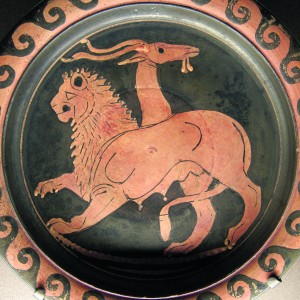SATURDAY, 7 MAY 2011
In 1998, karen keegan, a 52-year old woman from Massachusetts, received some extraordinary news. Tests revealed that she was not the mother of two of her three grown-up sons. While genetic tests had confirmed her husband as their biological father, the same tests had failed to detect a match between Karen’s own DNA and that of two of her children. When the tests were repeated, using new samples, the same results were obtained ruling out the possibility of mislabelling or cross-contamination in the lab. While it seemed possible that both sons had been swapped at birth, the chances of this happening to the same woman on two separate occasions, years apart, are incredibly small. In addition, Karen’s husband’s DNA had produced the expected match. Although this unlikely-sounding story is indeed true, the explanation may appear as strange as the finding itself.The breakthrough in solving the mystery came when researchers used a tissue other than blood to obtain a sample of Karen’s DNA. When genetic material from a cheek swab was sequenced, the anticipated match between Karen’s DNA and that of all three of her sons duly emerged. Further studies revealed that, remarkably, Karen’s body comprised two distinct populations of cells, each with its own unique genetic code. In Karen’s blood, one cell-type had come to dominate while in other tissues, including Karen’s ovaries, both cell types co-existed side-by-side. One of Karen’s sons had developed from an egg containing Karen’s first set of DNA—the DNA also found in the majority of her blood cells—while the other two sons developed from egg cells containing Karen’s second genome. Researchers believe that the most likely explanation for this phenomenon is that Karen’s mother may have conceived non-identical twins who, at an early stage of pregnancy, fused to form a single embryo, otherwise known as a chimera.
In Greek mythology, the Chimera was a fire-breathing female monster with the body of a lioness, the head of a goat, and the tail of a snake. In genetics, a chimera describes an individual in whom two or more genetically distinct populations of cells, derived from different individuals, co-exist. While chimerism is extremely rare, with only around 30 cases described to date, it is likely that many more instances of the condition go undetected, as there are usually no outward signs.
Microchimerism, on the other hand, is far from rare. Microchimerism may be described as chimerism diluted: whereas chimeric individuals have broadly similar numbers of cells derived from each constituent individual, a microchimeric person will possess approximately 50 ‘foreign’ cells per million of their ‘own’ cells. The most common source of microchimerism is transfer of cells, across the placenta, from foetus to mother. Foetal cells can be detected in the bloodstream of nearly all pregnant women by the third trimester and this cell exchange may actually help the mother’s immune system to tolerate the foetus. Interestingly, microchimeric cells do not appear to be fully eliminated after birth: stable populations of these cells have been detected in women many decades later. Notably, transfer across the placenta also occurs in the opposite direction—from mother to foetus—providing a mechanism through which infants may become microchimeric. The condition may also result from transfer of cells between twins as well as between unrelated individuals via organ transplants, bone-marrow transplants and blood transfusions.
Apart from producing occasional conundrums for geneticists, does chimerism—and indeed microchimerism—have any enduring consequences for health? The evidence for this is mixed, with both beneficial and harmful effects reported. In terms of harm, it has been suggested that microchimerism may increase the risk of developing a number of autoimmune diseases including scleroderma, rheumatoid arthritis and multiple sclerosis. A link was first proposed for scleroderma, a disease characterised by hardening of areas of skin or internal organs, after it was noted that the disease bore some resemblance to graft-versus-host disease. This is an autoimmune response that sometimes occurs following an organ transplant wherein the donated organ begins to attack the recipients’ tissues. One possibility, therefore, is that microchimeric cells may trigger an inappropriate and damaging immune response within their ‘host’. Many studies have reported an increased number of microchimeric cells in scleroderma patients as well as in those with other autoimmune diseases. However, not all autoimmune disease sufferers show microchimerism, and clearly not all microchimeric individuals develop autoimmune disease.
The fact that both microchimerism and autoimmune disease are affected by pregnancy may offer a further clue. Most autoimmune diseases are markedly more common in women with clinical onset typically occurring around the child-bearing years. And yet, paradoxically, some patients find that their symptoms actually improve during pregnancy, but return shortly after the birth. Studies into rheumatoid arthritis suggest that the relationship between pregnancy and autoimmune disease may depend upon human leukocyte antigen (HLA) genes. HLA class II genes exist in many different variants and are known to play a key role in determining immune responses. If a mother and foetus possess relatively distinct HLA gene variants, arthritis symptoms are likely to improve during pregnancy, while if mother and foetus have more similar HLA types, symptoms tend to remain constant or to worsen. Outside of pregnancy, the degree of HLA compatibility between microchimeric cells and their host may likewise be one of the key factors that determine whether microchimerism is an autoimmune friend or foe.
When it comes to cancer biology, microchimerism is viewed in an altogether more favourable light. Women who have previously been pregnant and who show microchimerism appear less likely to develop many forms of cancer. They also show greater therapeutic response and better survival rates, as compared to women who have previously given birth but in whom microchimerism cannot be detected. The evidence seems to be particularly strong in the case of breast cancer. In a mouse model of the disease, microchimeric cells were detected in large numbers at the tumour site. These cells did not express tumour-markers, however, and did not behave like tumour cells; instead they appeared to be helping with cell repair. Microchimeric cell transfer, from foetus to mother, may be particularly beneficial in this regard as some of the cells transferred appear to be pluripotent stem cells with the potential to develop into any of a number of different cell types. In a rat model of liver and kidney disease, for example, microchimeric cells have been observed moving to the site of the two organs, transforming into hepatocytes and renal tubular cells, respectively, and seemingly engaging in repair of damaged tissue.
The precise mechanisms through which microchimeric cells exert their effects remain largely unknown. Indeed, it is often difficult to identify the role that microchimeric cells are playing. They may be innocent bystanders, accomplices to automimmune diseases, or helpful agents in cell repair. Multiple factors including HLA type, the origin of the microchimeric cells and the length of time since cell transfer may all influence which of these roles microchimeric cells adopt under any given set of circumstances. One thing that is clear is that many of us may have rather more in common than we previously thought.
Louisa Lyon is a postdoctoral researcher in the Department of Experimental Psychology




